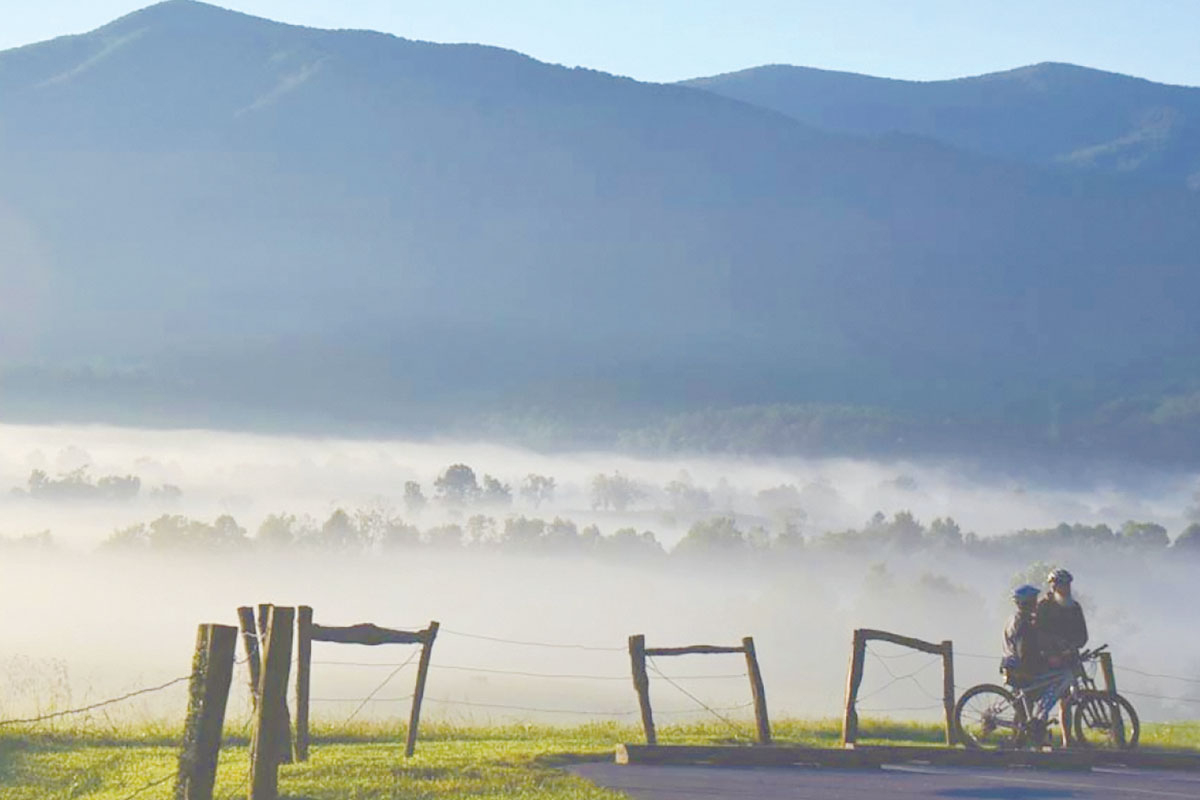WNC tourism trends
Motorcyclists
Maggie Valley business owners have seen an uptick in motorcycle enthusiasts with the opening of the Wheels through Time Museum.
Brenda O’Keefe, owner of Joey’s Pancake House, says many more motorcyclists are rushing to the Smokies to ride the Blue Ridge Parkway, the Dragon and other twisty roads.
More motorcycle rallies in Haywood have attracted bikers, but they’re not the kind of bikers most would expect.
O’Keefe said while convertibles were the go-to vehicle for the wealthy in the past, it’s now motorcycles that are the status symbols.
“We see doctors, lawyers, more upper-class people riding expensive bikes,” said David Huskins, director of Smoky Mountain Host, a regional tourism organization.
Moreover, motorcycles aren’t only for males. More females are riding their own bikes rather than taking a backseat.
Visitors who stay
With beautiful environs situated relatively close to major metropolitan areas, WNC has long attracted second- and third-homeowners from Georgia, Florida, South Carolina, Alabama and other Southeastern states.
Many of these part-time residents visit before buying. The second-home market especially spiked in the mid-1980s and continued to grow — until the recession stopped it in its tracks.
“This is the first recession that actually hit the luxury market,” said David Huskins, director of Smoky Mountain Host, a regional tourism organization. “Previously, they’ve been immune to that.”
Karen Wilmot, Swain County Chamber of Commerce director, testified to a surge of second-home buyers there in the past five years. When folks in Atlanta realize they can get to WNC in three hours, the area shoots up in popularity.
But the Swain Chamber doesn’t deliberately advertise the area as an ideal place for a second residence.
“We don’t really push it as come and live. We push it as come and stay,” said Wilmot.
Word of mouth is the best marketing tool by far, according to Wilmot.
Foreigners
The Smokies have witnessed a noticeable rise in foreign visitors in the last decade. Favorable currency rates and concentrated international marketing have brought more Germans and Brits to the region than ever before.
Many international tourists are flying into Washington, D.C., picking up the Blue Ridge Parkway in Virginia, getting off in Cherokee, then flying back out from Atlanta.
More Scandinavian and Swedish tourists are beginning to join their German, English, Irish and Scottish counterparts in the Smokies.
Fishing
After Maggie Valley and Waynesville were designated Mountain Heritage Trout Waters cities two years ago, more families are coming to the area to take kids fishing. The designation means anyone can pick up a three-day fishing license for just $5 and check out equipment at discounted prices.
Jackson County has also seen a rise in visitors after instituting a fly-fishing trail and ap two years ago. Visitors are coming from as far away as Texas and Montana for the first time.
Cherokee has also become a fly-fishing Mecca after opening catch-and-release sections on Raven Fork and the Oconaluftee River stocked with trophy trout.
Fido-friendly
Jackson County is seeing more tourists traveling with pets – so many that it has added a pet icon to its visitor guides to let tourists know which accommodations allow pets.
Julie Spiro, director of the Jackson County Chamber of Commerce, said it may seem like a minor trend, but traveling with pets is becoming more important than ever to consumers.
Over in Macon County, the new Smoky Mountain Performing Arts Center in Franklin has led to a rise in traveling concert-goers. Visitors from outside WNC are now heading to Franklin to see their favorite musicians perform.
Summer poses challenge for feeding low-income kids
Thousands of poor and low-income children across Western North Carolina rely on schools to get least at one square meal a day, but with classes now out for summer, there’s no easy solution for keeping kids fed.
“This question has been asked many times, and we’re trying to come up with a solution for the problem,” said Beth Stahl, MANNA Food Bank youth programs coordinator. “It’s scary to know they don’t have nutrition on a regular basis. We’re trying to fill in the gaps, but it’s a slow process.”
Throughout North Carolina, about 700,000 children qualify for free or reduced meals during the school year, but only 53,000 or about 8 percent get free meals during the summer, said Cynthia Ervin, North Carolina summer food service programs coordinator.
“We have a lot of work to do,” Ervin said. “I believe we can do better than 8 percent.”
The United States Department of Agriculture reimburses approved programs $1.85 per breakfast, $3.25 per lunch and 76 cents per snack.
But nonprofits, schools or other programs have to be in charge of preparing the food and keeping up with the paperwork required for reimbursement.
“It’s definitely one of the most needed federal programs,” Ervin said. “But it is the most underutilized program.”
In Macon County, 66.6 percent of the 4,239 students enrolled in public schools are eligible for free or reduced lunch. But no programs are in place to ensure those 2,825 children get good nutrition during the summer.
“It’s because we don’t have organizations that are interested or aware of the program,” Ervin said. “They just haven’t stepped up to the plate.”
Jackson, Swain and Haywood counties all have free meal centers and programs to reach kids who need food. But the number of kids fed during the summer through these programs still falls well below the number eligible for free or reduced meals during the school year.
In all three counties, any child up to 18-years-old can simply go during the right time to an open meal site and get a free meal. Proof of lower-income status isn’t required in counties where more than 50 percent of the student population is eligible for free or reduced lunches during the school year.
In Jackson County, 52 percent or about 1,500 to 1,800 students are eligible for free or reduced lunch during the school year, said Jim Hill, director of child nutrition. But in summers past, free lunch and breakfast programs have served only about 250 meals a day.
This year, Hill anticipates that number will double, he said.
“There is a major effort in North Carolina to get the feeding numbers up, and we want to be a part of that,” Hill said. “It’s going to take a lot of effort to get a lot of people involved.”
Led by Jeffery Vickery, senior pastor at Cullowhee Baptist Church, volunteers are delivering lunch to children at four free meal sites in the Tuckasegee, Cullowhee and Canada communities every weekday this summer to expand the reach of the program to more remote areas.
“These kids are spread out in little pockets everywhere,” Hill said. “You want to take it right to their neighborhood, and that’s the tough part.”
Vickery met with school officials to determine which areas had the poorest children and estimated the number of meals to prepare based on how many kids get off at nearby school bus stops.
“This is filling a gap that no one else has,” Vickery said. “The children needed the food. We are just a conduit willing to do it.”
Staff at Smoky Mountain High School prepares lunches that meet strict government nutrition guidelines, and Vickery and his crew deliver them.
Last week — the first week the four satellite sites were open — Cullowhee Baptist Church distributed 151 meals, Vickery said. He anticipates the number will increase as more children learn about the sites, he said. On Fridays, the students also get bags of food to take home for the weekend.
“We said going in that if there were four or five kids who didn’t go hungry this summer, it would be a success,” Vickery said.
Even with the new meal sites, about two-thirds of students who are eligible for free or reduced lunch during the school year aren’t taking advantage of summer feedings.
“The big challenge is that there’s other children we can’t get to,” Vickery said. “The difficulty is knowing we could feed twice as many if we had other people willing to host a site.”
Although Jackson County has seen a great improvement in the number of children getting lunch during the summer, Swain and Haywood counties only have one location where meals are served to the general student population.
In Swain County, 1,230 of 1,880 or 64 percent of enrolled students are eligible for free or reduced price meals during the school year, said Diane Shuler, Swain County school food service director.
Swain County Schools will offer breakfast and lunch at the Swain Middle School cafeteria seven weeks during the summer, starting next week.
Last year, between 140 and 150 kids came to the middle school each day to get food. Most of those children attend summer camps. Few come in off the street, Shuler said.
Although Haywood County has several meal sites, only one — the Pigeon Community Center — is open to the general public. The rest serve students in specific summer day camps.
The Pigeon Community Center also offers a summer camp for eight or nine weeks each summer and usually enrolls between 37 and 47 children, program coordinator Lin Forney said.
Forney said the day camp focuses on children whose families can’t afford other summer camps. For the entire summer, the camp costs $200. But any child up to 18 years old can come in for breakfast or lunch, Forney said.
Besides a handful of children just down the street from the center, relatively few children come in for the meals, Forney said. She said she never sees children from other parts of the county like Canton, Clyde or Maggie Valley.
“The major issue is transportation,” Forney said. “Awareness is another factor.”
During the school year, 42 percent of enrolled students in Haywood County Schools are eligible for free lunch and another 9 percent can receive reduce priced lunch. Allison Francis, Haywood County director of child nutrition, said she is sure some children fall through the cracks, and other organizations are stepping up to try to fill the gaps.
In addition to meal sites this year, MANNA Food Bank is supplying food to Haywood Christian Ministries, which in turn will distribute it every Friday to eligible kids through a program called Summer Sacks.
The kids will receive between four and a half and five pounds of food, which may include pasta meals like Hamburger Helper, dried beans, rice, fruits, vegetables and a smaller bag of kids’ snacks, Stahl said.
“With what the family is already receiving from the food bank, I would say it would last about a week,” Stahl said.
Summer Sacks is a spin-off of a similar effort in Haywood County during the school year. School counselors identify students in need of extra food on weekends, and teachers stuff it in the kids’ backpacks on Fridays to get them through until Monday, Stahl said.
The last week of school, these same students got notes put in their backpacks to let their parents know they can pick up extra food bags at the Haywood Christian Ministries this summer.
Nobody knows how many kids will come for the summer backpacks, however, Stahl said.
The Summer Sack program started with a food drive led by Bonnie Williams with the Waynesville office of Keller Williams Realty. The company does regular service projects, and Williams raised the question in a planning meeting for their spring project.
“I said, ‘Does anybody know where these kids get their food in the summer?’” Williams said. “Over the summer there would be two months where they wouldn’t get food. So we decided to take it on.”
The realtors gathered food at four locations in Waynesville and collected more than 1,500 pounds of food on a single day in May. There was so much food, they couldn’t fit it into their cars to take to MANNA. Instead MANNA had to send a truck, Williams said.
“We didn’t know how much food it would take so we worked our butts off,” Williams said.
Summer meal sites for school kids
Jackson County
• Tuckasegee Baptist Church
• River Park Trailer Park (Cullowhee)
• Jackson County Recreation Complex
• Canada Community
Lunch 12:30 – 1:30 p.m.
Haywood County
• Pigeon Community Center
Breakfast 8:30 – 9:30 a.m.
Lunch 12:30 – 1:30 p.m.
Swain County
• Swain Middle School
Breakfast 7:30 – 8:30 a.m.
Lunch 11:15 a.m. – 12:30 p.m.
Macon County
• None
Wanting to help?
Organizations interested in sponsoring meal sites should contact Cynthia Ervin, North Carolina summer food service programs coordinator, at This email address is being protected from spambots. You need JavaScript enabled to view it..
Ervin begins recruiting new sponsors in the fall and visits potential organizations. Organizations must apply and be approved before they can get reimbursement, and volunteers must go through training.
There’s no minimum requirement for how many days or weeks an eligible organization serves meals during the summer or how many kids get fed through the site, Ervin said.
“We want them to do whatever they are capable of doing,” Ervin said.
WNC’s economic stimulus lies in tourism
By David Huskins • Guest Columnist
Much of the talk nationally, as well as locally, has been centered on how to get our economy moving again. Policy proposals and local budgets are being measured by whether they will create jobs and stimulate spending.
While a contentious debate about the right policy rages in Washington, D.C., there may be an answer that is much less controversial, easier to implement and, best of all, could yield better results right here in Western North Carolina.
I’m talking about investing in our travel and tourism economy.
Many people don’t realize it, but the travel and tourism industry is one of our most important economic drivers.
Nationally, travel and tourism is responsible for $704 billion in direct spending, 7.4 million direct jobs, $186 billion in payroll and $111 billion in tax revenue. There are few industries that can compete with this kind of output.
The story applies locally. Here in Western North Carolina alone, travel and tourism in 2008 was responsible for 27,100 jobs, $509 million in payroll, $2.4 billion in expenditures, $99.7 million in local tax receipts and $119.3 million in state tax receipts (N.C. Department of Commerce).
Simply put, when people travel either for leisure or business, the economy grows, jobs are created, and tax coffers filled.
So how can we in WNC invest in this precious resource and leverage it to bring our economy back?
Here are some ideas:
Promote meetings and events. Meetings and conferences are essential to business productivity. We need to support them. Corporate meetings are a major driver of local jobs and a boost to local spending. When these meetings dry up our communities’ small businesses and workers suffer. So we need to do what we can to support the meetings and events industry, and encourage more businesses and associations to bring their meetings to Western North Carolina. We have some of the nation’s finest resort and convention hotels right here in our backyard.
Promote WNC as a regional tourist destination. Our 23-county region has everything a leisure traveler wants. With the nation’s two most visited national park units — Great Smoky Mountains National Park and the Blue Ridge Parkway — and the the two highest recreation-user-day national forests (when snow skiing is excepted) — Pisgah and Nantahala — we’re an outdoor Mecca. Our natural resource base provides some of the most popular warm climate snow skiing, fishing, hunting, backcountry hiking and camping, bicycling and whitewater recreation areas in the nation.
We’re the home of the Cherokee, the most recognized Native American Indian Tribe in the world. Our craft, culture and heritage are significant, bringing us recognition by the U.S. Congress as the 23rd National Heritage Area — the Blue Ridge National Heritage Area. And just last month, our Nantahala Gorge was chosen by the International Canoe Federation in Budapest, Hungary, as the site of the 2013 World Canoe Freelance Championship (the X Games of canoeing and kayaking). That event will attract 500 competitors from 50 countries and 100,000 spectators over 10 days, garnering WNC unparalleled international sports media coverage.
It’s time that we help our local tourism organizations understand the value of working more closely together and allocating some of their resources to promote collectively WNC as a true regional destination. It’s time that we help our local economic development organizations understand the value of the travel and tourism industry to our regional economy and how to engage it and support it in their various initiatives.
Attract international visitors. When people travel from other countries, they tend to stay longer and spend more when they are here — a windfall for our local retailers and other small businesses. A national communications and marketing program called the Travel Promotion Act was just passed by Congress, which will invest in marketing to these visitors. That is great news for us since tourism research studies indicate that European and Asian leisure travelers identify our Blue Ridge-Smoky Mountains-Cherokee region as their favored destination for a trip to America.
On a final note, we need to make sure our local, state and federal elected officials understand the value of travel and tourism to our regional economy. And we need to make sure they are recognized when they go to bat for travel and tourism. Our regional economy is beginning to turn around, but we need to continue to invest in the recovery.
The week of May 8-16 is National Travel and Tourism Week. It’s a great opportunity to let our elected officials know that we support and appreciate everything they are doing to get people moving again.
(David Huskins is the managing director of Smoky Mountain Host of N.C., a regional travel and tourism promotion and development organization created in 1987 for the state’s Smoky Mountains region of Haywood, Jackson, Macon, Clay, Cherokee, Graham and Swain counties and the Cherokee Indian Reservation. He can be reached at This email address is being protected from spambots. You need JavaScript enabled to view it..)
President and First Lady Obama get a taste of WNC’s locally-grown food scene
Just a month ago, no one here would believe that the President and First Lady of the United States would one day be savoring smoked trout from Sunburst Farm in Canton while on vacation. Or munching on fresh lettuce directly delivered from Jolley Farms, also in Canton.
The small Western North Carolina town has officially connected with the White House, and in more ways than one.
Denny Trantham served Barack and Michelle Obama at The Grove Park Inn, where he works as executive chef. Trantham, too, hails from Canton. It’s where he grew up, and where he held his first job as a dishwasher at a local restaurant in the late ‘80s.
Trantham is the reason those local products showed up on the menu in the first place. As the visionary responsible for crafting Grove Park’s menus months in advance, he has always placed a special focus on utilizing local products no matter what changes are made to restaurant offerings.
It’s the relationships he’s built with farmers over the years that has made the resort’s local farm-to-table program a hit.
“I’ve known these people a long time,” said Trantham. “If I need trout, I know where to go. If I need peppers, I know where to go.”
Grove Park consistently incorporates farm offerings produced within a 100-mile radius in the menus of its multiple restaurants, using bacon from Hickory Nut Gap Farm in Fairview or goat cheese from Three Graces Dairy in Madison County, for example.
When the program began three years ago, only a handful of farms participated. It was a trial-and-error process, and some were overwhelmed with the quantity Grove Park demanded every day.
Trantham must be selective about how much local produce is offered at each of the inn’s restaurants since it is not available on a large scale.
“If I’m feeding 1,200 and I gotta have salad greens, that’s a challenge,” said Trantham.
But local farms have adapted over the years, including Jolley Farms in Canton, which built its own greenhouse to use during winter months and continue supplying the resort with produce.
“It’s as close as you can get to year-round,” Trantham said.
Trantham’s enthusiasm for local produce existed long before it became a ubiquitous trend.
He learned all he knows from his mother and grandmother, who kept up gardens with green beans, corn, squash and zucchini. They also made their own jam, jellies, preserves, relishes, and pickled vegetables, making sure to never waste a thing.
“The funny part today is that everyone’s crazy about farm-to-table, but I think it’s something we did all along,” said Trantham, who believes the local food movement is more than a passing fad. “This isn’t a trend by definition. This is going to be a way of life.”
Southern Appalachian culinary traditions have been another mainstay at the Grove Park Inn since Trantham joined the staff nine years ago, and he intends to keep it that way.
That dedication in particular helped bring traditional Southern cooking to the Obamas.
Though President Obama stopped by at the historic inn while on the campaign trail, the latest visit was a whole different ballgame.
As Obama fans watched his every move, Trantham and fellow chefs were simultaneously subject to scrutiny from security each time they prepared the president’s meal.
A few changes to the Sunset Terrace restaurant menu were made, though Trantham is barred from discussing much about the meal, like what was exactly served or even who sat at the table with the Obamas.
Trantham said the hardworking kitchen staff was experiencing an “ounce” more of stress during Obama’s visit. They not only had to prepare an impeccable dinner for the president and first lady, but also a quality dining experience for 300 guests in the other dining room at the same time.
Ten chefs worked busily in the kitchen that night, while usually six suffice.
“We survived,” said Trantham. “I feel like we learned how to once again survive under pressure.”
Trantham introduced the menu to the Obamas, who tried a taste of ramps and were especially interested in learning more about Grove Park’s farm-to-table program.
“They enjoyed everything about their meal, and the president and first lady were gracious enough to meet each and every one of our chefs,” said Trantham, who characterized the Obamas as “down-to-earth” and “hospitable.”
Obama shook each chef’s hand, and announced that it was a perfect photo opportunity. “That was our moment in the spotlight,” said Trantham. “It was a great surprise for all of us, but it’s one that we’ll never forget.”
Since then, Trantham says the resort has received dozens of inquiries from those piqued by Obama’s stay there. Trantham by no means believes he’s reached a peak in his career by working as executive chef at the luxury resort, and now, serving the President.
“A lot of people say you’ve made it,” said Trantham. “In my mind, I’ve not made it. I’m just starting ...You gotta keep moving, you gotta keep growing, you gotta keep inventing, you gotta stay ahead of the curve, all the time.”
Deadly fungus could annihilate even the most common bats
Nine bat species across the South are at risk from a deadly fungus decimating certain bat populations known as white-nose syndrome.
The disease has now been confirmed as close as Tennessee and Virginia. Susan Loeb, a leading bat expert with the Forest Service’s Southern Research Station, says it is just a matter of time before white-nose syndrome is detected in North Carolina where nine bat species are presumed at risk.
“Little-brown bats and Indiana bats are among the most threatened by white-nose syndrome — meaning their populations could either be seriously decimated or become extinct,” said Loeb. “Historically, little-brown bats were quite common, but the species appears to be especially susceptible to the fungus and is being hit hard in the states where WNS has taken hold.”
White nose syndrome affects bats that hibernate in caves and mines. The disease received its name because of the white fungus often seen on the noses, muzzles and wings of infected bats. More than a million bats have died as the result of white-nose syndrome.
So far, white nose syndrome is confirmed in 11 states from Massachusetts to Virginia. The first case of the disease in the United States was reported in New York in 2006. Some experts believe the disease originated in Europe.
Oversight of mental health foundation called into question
Western North Carolina’s mental health agency may be headed for a civil war with its partner foundation.
Smoky Mountain Center, a quasi-state body that oversees mental health in the region, hopes to wrest $20 million in assets away from its sister nonprofit, citing a lack of oversight for public funds.
For three decades, the Smoky Mountain Center has relied on its nonprofit foundation Evergreen to bolster mental health and substance abuse services in the region.
But the foundation has grown increasingly estranged from the agency it was intended to support, according to board members of Smoky Mountain Center.
“There has been a disconnect there,” said Ronnie Beale, a member of the Smoky Mountain Center board and Macon County commissioner.
Communication between the two entities is sparse to nonexistent. The center’s requests for financial assistance have repeatedly been turned down, and the foundation won’t even disclose how its funds are being spent, according to Brian Ingraham, the executive director of Smoky Mountain Center.
“It is not supposed to be some organization off on their own with no public oversight,” Ingraham said.
Ingraham and his board of directors have proposed a major overhaul of the foundation to bring it under the auspices of Smoky Mountain Center.
“The bottom line is the board thought these funds should be under public scrutiny,” Beale said. “We feel it is public money, and it should be under public oversight.”
A letter was sent to foundation board members this week asking for a meeting within 30 days to discuss the issue.
Tom McDevitt, the executive director of the Evergreen Foundation, has little to say for now.
“Until whatever meeting takes place between Smoky Mountain and whoever, we are not going to be able to comment,” McDevitt said.
Until recently, the foundation and Smoky Mountain Center shared the same director — McDevitt. But McDevitt resigned from Smoky Mountain Center under pressure in fall 2008. McDevitt had come under scrutiny for using his position for personal financial gain.
He managed to hang on to his position as director of the Evergreen Foundation, however, which had a different slate of board members.
McDevitt disagrees with the line of argument Smoky Mountain Center is presenting.
“I don’t feel there is any disconnect whatsoever,” McDevitt said.
McDevitt said he has met with the board of Smoky Mountain Center whenever he’s been asked. But when Smoky Mountain Center needed an emergency meeting over state budget cuts, Ingraham said it took weeks to get it arranged.
State budget cuts axed $10 million over two years from indigent care — a fund that covers mental health and substance abuse treatment for those who can’t afford it. The 20 percent cut means poor people who need therapy or treatment won’t be able to get it now.
Smoky Mountain Center asked the foundation for a $2 million grant to make up some of the difference.
“Wouldn’t this seem like exactly why the foundation was developed?” Ingraham said.
But the foundation granted them only $200,000. Smoky Mountain Center also asked the foundation to forgive their rent for the year.
Smoky Mountain Center pays $280,000 a year in rent to the foundation for office space and a mental health and substance abuse clinic called The Balsam Center.
The two buildings were bought and paid for with state money given to Smoky Mountain Center but were then passed along to the foundation, which manages the properties.
The foundation owns the buildings as a result. Ingraham said it is wrong that the foundation won’t cut Smoky Mountain Center a break on rent when they paid for the buildings in the first place, Ingraham said.
“We gave them the money, but now they say ‘We aren’t going to help you,’” Ingraham said. “That was the point where people realized there was nothing appropriate or correct about this any longer.”
But McDevitt said the foundation’s purpose is about more than helping Smoky Mountain Center. Its mission is to support people with mental health, substance abuse and developmental disabilities throughout the seven counties.
“That is the sole purpose of the Evergreen Foundation,” McDevitt said. “We have done a very good job of that over 33 years.”
That mission, he said, can include making grants to private practices that offer counseling and mental health treatment other than Smoky Mountain Center. McDevitt said that the foundation has given out $200,000 in grants to private mental health practices this fiscal year.
Ingraham said he has asked McDevitt to share what grants have been given out and how the foundation is spending money.
“We have asked for that information, and it has not been forthcoming,” Ingraham said.
McDevitt disagreed.
“They did know about them. Of course they knew about them,” McDevitt said of the other grants.
How it all started
When Evergreen Foundation was created in the late 1970s, it was out of necessity. State agencies couldn’t buy and resell property, and Smoky Mountain Center needed to amass an inventory of office buildings for mental health and substance abuse counselors to work out of throughout the seven western counties.
But the law has since changed, and state agencies can now act as their own property management arm.
While the foundation has always had its own board of directors, it was historically tightly controlled by Smoky Mountain Center. Early on, the Smoky Mountain Center appointed the foundation board, and many of the members sat on both boards.
But in 2001, when the state launched mental health reform, everything was on the table from privatizing mental health services to consolidating the regional agencies like Smoky Mountain Center.
In the ensuing turmoil, Smoky Mountain Center feared the state would attempt a money grab to seize the assets of the foundation. So it purposely built a firewall around the foundation. Bylaws were rewritten to make it a private entity, separate from Smoky Mountain Center.
“It was done to protect the assets for their intended purposes,” said Shelly Foreman, community director for Smoky Mountain Center.
At the time, no one envisioned that the foundation would one day end up with a completely separate director and board that had little interaction with Smoky Mountain Center, Foreman said.
“It was never the intention that Evergreen be disconnected from what the service needs and funding needs are in the community,” Foreman said.
Ingraham and his board hired an auditor to track all the money that had gone into the foundation since its creation in 1977. They determined $14.5 million in county and state tax dollars have flowed into the foundation’s coffers.
Nearly all of the money was for purchasing buildings in the seven western counties — from office space for mental health counselors to substance abuse clinics to the central headquarters for Smoky Mountain Center.
Smoky Mountain Center once operated its own teams of mental health counselors, therapists and psychologists throughout the region, housed in the office space owned by Evergreen but paid for initially with state funds.
The state has since privatized mental health, so most of that office space is now rented to private mental health practices — or in some cases to whoever is willing to rent the building whether the tennant was in the mental health field or not. The foundation keeps all the rent money.
Ingraham said the foundation is operating more like a property management and investment company than a nonprofit with a mission to fulfill.
“It is income that was generated from public money,” Ingraham said.
But McDevitt said the origin of the money isn’t relevant. It started out as public money, but was given to a private organization to carry out its mission.
“Where it goes to, it loses its identity as public funds,” McDevitt said.
The upshot
Smoky Mountain Center wants a new governing structure for the foundation. The proposal calls for the current foundation board to be dissolved. A new foundation would then be created under a new set of bylaws — stipulating that Smoky Mountain Center gets to appoint the board and hold a majority of the seats.
While the board of Smoky Mountain Center is a public body — meaning their meetings, financial records and actions are open to the public — the foundation meets in private and has no obligation to share its financial information other than its annual nonprofit tax filing.
The aim is to restore public oversight, Beale said.
The 30-member board of the Smoky Mountain Center voted unanimously for the proposal earlier this month.
To back-up the proposal, county commissioners from the seven western counties have been asked to pass similar resolutions over the next two weeks. Macon County commissioners were the first to do so this week.
Macon County’s resolution says if diplomatic efforts fail, legal routes may be necessary.
John Bouknight of Highlands, the president of the Evergreen Foundation board, would not comment in detail until after meeting with the Smoky Mountain Center board.
He said Evergreen’s mission goes far beyond just supporting the needs identified by Smoky Mountain Center.
“They aren’t everything,” Bouknight said. “I think we are following our mission statement. These are all very dedicated people.”
The foundation board only meets four times a year. Beale said he trusts that their primary interest is serving mental health and substance abuse needs, but he isn’t sure how informed they are.
“The only thing they know is what their director tells them,” Beale said. “I do have a lot of respect for some members on that board, and I think their heart is in the right place and will do the right thing.”
In the meantime, Smoky Mountain Center has alerted the state attorney general’s office of the unusual situation.
“We are talking about state funds that now exist within an organization that has no affiliation within Smoky Mountain Center and chooses to do whatever they want with it,” Ingraham said.
EPA ozone standards
Limit prior to 2008: .08 parts per million
New limit set in 2008: .075 parts per million
New limit pending in 2010: Between .06 and .07 parts per million
How WNC stacks up
Ozone levels have improved gradually in WNC over the past 10 years. They can vary widely from year to year depending on weather, however. Wetter and cooler summers see fewer bad ozone days that hotter, drier ones.
To determine whether WNC meets the new ozone limits, an average of three years worth of ozone readings — from 2008 through 2010 — will be used.
Here’s the levels for ozone monitoring stations in the region based on the three-year average from 2007-2009. Ozone is worse at higher elevations and surprisingly consistant across the mountains.
Waynesville .068 parts per million
Bryson City .064 parts per million
Asheville .069 parts per million
High elevation sites
Purchase Knob .074 parts per million
(near Hemphill Knob above Jonathan Creek in Haywood County)
Frying Pan .074 parts per million
(near Mount Pisgah off the Blue Ridge Parkway in Haywood County)
Mount Mitchell .074 parts per million
(highest elevation on the east coast)
• A monitoring station has been recently installed on Barnet Knob on Cherokee Indian Reservation and will be providing data this year.
GOP hopes voter anger will help beat Shuler
Republicans hope 2010 will be their year to reclaim the congressional seat representing Western North Carolina — a seat they had long held but was wrested away in 2006 by political newcomer and football star Heath Shuler.
Whoever wins the Republican primary for the 11th Congressional District, however, will have their work cut out for them.
“This is not going to be a cake walk for anybody,” said Jake Howard, a candidate from Franklin.
While Democrats are vulnerable on the national stage, Shuler isn’t exactly a raging liberal, much to the chagrin of die-hard Democrats in the district. He’s good looking, a family man, and a devout Christian. People line up for his autograph when he makes public appearances — due more to his football fame than status as congressman
Money will be a major factor in the race against Shuler. Shuler has lots of it, and none of the Republican candidates in the running have a hope of matching it. The big question is how much money the national Republican Party will funnel to Shuler’s opponent.
“I think no matter who our primary voters elect we are going to see the national Republican Party here,” said Robert Danos, the chairman of the Henderson County Republican Party and a Shuler critic.
But Republicans have their eye on taking back many seats in 2010, so competition for national financial backing will be stiff.
“I think the Republican Party will focus first on open seats,” said Chris Cooper, a political science professor at Western Carolina University.
Shuler’s seat would likely be a close second in line, however.
“Shuler is a vulnerable Democrat in a district that has shown it will vote for Republicans, so after putting money into open seats, this will be one of the races they look to — especially if the nominee is a candidate the national party thinks will do well,” Cooper said.
The Republican challengers are downplaying the importance of funding in this year’s election.
“It will be incumbent on whoever wins to raise a lot of money, but money alone is not going to do it this year,” said Greg Newman, a candidate from Hendersonville. “The message this year is going to be more important than ever before.”
Fellow candidate Jeff Miller agrees to a point.
“It doesn’t mean you can go in there with $100,0000 and beat Heath Shuler. He is going to dominate airwaves and he is going to dominate mailings,” Miller said.
Only two candidates have paid campaign staffs at this point. Miller and Dan Eichenbaum, who each have three paid staff.
Shuler is not only a multi-millionaire, but has also already amassed a formidable war chest. He had $1.27 million in the hopper as of January before his main fundraising push has even started.
In 2008, Shuler raised $1.67 million but spent less than $800,000 against a comparatively weak opponent in Carl Mumpower.
Coattails effect
Republicans are holding out hope that a national tide will carry them to victory against Shuler.
“I think he is going to be very vulnerable precisely because this election, just like congressional elections across the country, is going to be much more about the national issues than just ‘Do you like the guy,’” said Danos.
But whether the country is headed for a Republican landslide this year that will hurt Shuler is unpredictable for now.
“I think this is definitely going to be a better year for Republicans than it is for Democrats,” Cooper said. “That said, I think where we are really going to see that is with the open seats. Shuler is an incumbent, and for incumbents to lose they pretty much have to shoot themselves in the foot during the election.”
Not just any candidate can ride a Republican tide to defeat Shuler, Miller said.
“I think you are going to have to have the right person,” Miller said.
All candidates agreed on that point, although opinions obviously vary on who that “right” candidate is.
“This race is all about who can beat Shuler,” said Jake Howard, a candidate from Franklin. “If the Republican voters send a neophyte up against Heath Shuler he will eat their lunch.”
The most electable candidate in a general election doesn’t always emerge as the top vote-getter in a primary.
“Only a fraction of the voters are going to get to the polls,” Howard said. “So it is so easy to select the wrong candidate.”
Both years Shuler won — in 2006 and 2008 — were generally good years for Democrats.
“Many people, including a number of Republicans, were angry about things the Bush Administration did a poor job of managing,” Danos said. “But now they see turning the keys over to Nancy Pelosi and Barack Obama is much further to the left than many people who voted for Obama expected.”
Painting Shuler into the same corner as Pelosi and Obama is clearly part of the Republican strategy, but it might not be that easy. Shuler voted against the Wall Street bailout, against the auto bailout, against the stimulus bill and against the health care bill.
But Danos said as long as Shuler votes for Pelosi each year to serve as Speaker of the House, he is handing the agenda over to liberal Democrats.
“Shuler talks a good game at home of being a conservative,” Danos said. But in reality, he isn’t as conservative as he makes out to be, Danos said.
Nonetheless, many Democrats are angry with Shuler for being part of the Blue Dog caucus — a band of conservative Democrats who often vote as their own block.
But Cooper doubts that liberal Democrats will be angry enough to vote against Shuler.
“He will still be a better Democrat than a Republican will be,” Cooper said.
It would be too risky for Democrats to oust Shuler and sacrifice the seat to a Republican in the short term in hopes of getting a “real” Democrat to take the seat back two years from now, Cooper said.
“I think people aren’t willing to roll the dice that much,” Cooper said. “I think at the end of the day people vote for the candidate that holds the package of beliefs that are closest to them.”
Most electable?
Six months is a long time in American politics, and no one can predict if the Republican fury will fade or sustain itself. But Dan Eichenbaum, a primary candidate from Murphy, said the movement isn’t going away.
“The direction our country is going is so abhorrent to so many people,” Eichenbaum said.
Eichenbaum is a self-described Tea Party activist.
“I have been rolling up shirtsleeves and getting out my check book since last spring,” Eichenbaum said.
Candidates that cater to purist Republican ideals like Eichenbaum may resonate well in a primary. But the right-leaning base that dominates the polls in the primary may select a candidate that is less electable come the general election.
“In the primary you have to talk to the right, then in the general election move to the center,” said Ed Krause, a candidate from Marion.
But Eichenbaum said he refuses to compromise on his principles to win votes based on his audience.
“That’s what got us in this mess in the first place,” said Eichenbaum, who was at one time a registered Libertarian.
Eichenbaum is one of the leading contenders in the primary. But so is Jeff Miller, who is far more moderate.
Miller doesn’t engage in the level of Democrat bashing that has endeared Eichenbaum to his base.
“We all have a piece of this together,” Miller said of the national crisis.
Miller said his platform will make him a more viable opponent against Shuler come November.
“You have to decide what is going to play the best. The unaffiliated voter is huge in this district,” Miller said.
Especially if winning the general election could require wooing Democrats to break ranks.
“You can’t ignore this Tea Party movement. But I think in the end the established Republican is going to get the nomination and will get the most support from the national party and the voters of the 11th district,” Cooper said.
Unknown faces
Until now, the candidates are largely unknown except within their own counties. No one had true regional name recognition going into the race.
In a territory that spans 15 counties, candidates find themselves criss-crossing Western North Carolina several times a week in the final throws of primary season.
“It is very challenging,” Krause said. “My dogs don’t know who I am.”
Kenny West, who lives in Hayesville, has a long haul to get just about anywhere. He has been averaging 1,700 miles a week campaigning lately.
Newman said candidate forums and debates have been well attended.
“As opposed to a lot of primary election cycles people are very engaged about this particular election,” Newman said. “I believe it is symptomatic of how people feel about the country right now.”
WNC Fly-Fishing trail adds trophy trout water in Cherokee
The Western North Carolina Fly Fishing Trail has added a new stop on the map for anglers — the Raven Fork trophy water on the Cherokee Indian Reservation.
The fly-fishing trail leads fishermen to 15 different fishing spots in Jackson County, from narrow mountain streams to wide rivers. The Jackson Country Tourism Authority came up with the idea last year as a way to harness the potential of touring anglers.
“The Raven Fork trophy water enhances the trail’s overall experience because it provides a type of fishing not found anywhere else,” said Julie Spiro of the Jackson Country Tourism Authority. “It’s thrilling to catch fish on that stream. There are a lot of large trout in there.”
The 2.2-mile stretch is regularly stocked with large rainbow, brown and golden trout. It’s common to catch fish 20 inches or longer, and there are a number of trout that exceed 30 inches. Access is available through several pull-offs along Big Cove Road with paths that run along the stream.
The scenic Raven Fork replaces the Horsepasture River as spot number 6 on the WNC Fly Fishing Trail. Public access to the Horsepasture River is becoming increasingly limited, which prompted the change.
Raven Fork is designated by the Cherokee as catch and release fly-fishing only. Anglers wishing to fish Raven Fork need to purchase a $20 special use permit and a $7 daily permit from the Eastern Band of the Cherokee Indians.
Local guide Alex Bell, who helped create the trail, often has anglers request a trip to Raven Fork.
“Cherokee wants to be a destination east of the Mississippi River that every fly fisherman knows,” Bell said. “They have different strains of trout coming in and have great vision for their fishing program.”
The Raven Fork trophy water in Cherokee and the Tuckasegee River above Dillsboro are two of the most rewarding stretches for trout fishing in the region.
“Those are the two big boys. And they’re both on the trail,” Bell said.
800.962.1911 or go to www.FlyFishingTrail.com.
New standards to shine light on WNC air quality
New federal standards for ozone will be issued by year’s end, and the verdict will determine whether Western North Carolina is out of compliance with air quality.
Western North Carolina likely can’t fix its air quality problem alone. Charlotte, Knoxville and Atlanta are all out of compliance under current ozone limits, let alone the more rigorous ones that are pending. Smog is carried from these metropolitan areas into the mountains.
In addition, antiquated, dirty coal plants operated by Tennessee Valley Authority from Ohio to Tennessee to Alabama send pollution this way.
“Is there enough we could do in North Carolina to achieve the standards?” asked Paul Muller, regional supervisor for the N.C. Division of Air Quality in Asheville.
Probably not, he said. But since WNC won’t be alone in its violation of ozone standards, a multi-state approach will be inevitable.
“Knoxville has a problem. Atlanta has a problem. So they are going to have to be making reductions as well,” Muller said.
Ozone levels have declined over the past decade, proving that tailpipe regulations and new emissions standards gradually being imposed on coal plants can work, according to Muller.
“How do we keep getting cleaner so we can meet the tighter standards?” Muller said. “In a lot of ways we depend on the federal government to put in reduction programs that will affect a larger area.”
But attempts to impose tougher pollution limits on coal plants have met resistance in court. The benefits that would otherwise be realized by new regulations are taking longer, Muller said.
While it is easy to point fingers at dirty coal plants or wafting smog from urban centers, it will ultimately take everyone working together to improve air quality — including steps by everyone living in the region.
“Air quality is impacting our health our environment and our economy,” said Bill Eaker, environmental specialist with Land of the Sky Regional Council. “We are going to have to take action to reduce energy consumption and reduce fuel use for our cars and vehicles.”
Ozone, which is the main ingredient in smog, is worse in the summer. The Land of the Sky Regional Council hosted an ozone season press conference last week, as it does every year at the outset of the ozone season. Speakers at the event educate the press on the latest air pollution rules, tout success stories and share various initiatives underway throughout the region to improve air quality.
Limit in flux
An ozone standard is set by the Environmental Protection Agency every five years. New limits came out in 2008, but have been in flux ever since, due both to lawsuits and a shift in policy from the Bush to Obama administration.
When reviewing the ozone standard, the EPA relies on a panel of scientists to recommend a safe limit both for human health and the environment. But in 2008, the EPA bucked the scientists and instead settled on a slightly laxer number.
“This was a big deal because EPA usually takes the advice of its science committee,” according to Vicki Sandiford, an air quality specialist with the EPA in Raleigh. “The law requires EPA to explain in a rational way why it chose not to follow the recommendation of its science advisers.”
Apparently, the explanation was lacking, since lawsuits by environmental groups promptly followed. The scientists on the panel even weighed in expressing anger that their advice was not followed.
When Obama took office, he appointed a new EPA director, and a policy shift followed suit.
“It is the goal of this administration to have science in the forefront of the regulations it considers,” Sandiford said.
So it was back to the drawing board. The new ozone standards will be announced by August (see box).
There are 1,200 ozone monitors in the United States, mostly in urban areas. The EPA wants to see 270 new monitors installed throughout the country.
With many areas in violation of the old ozone limits, it is unclear how quickly even tougher limits will be complied with. Charlotte has been in violation of federal ozone standards since 1997. Why such a long leash to meet the standards?
“Partly because of the difficulty for many areas in meeting the standard,” Sandiford said. “They want to give area time to put programs in place and see the results it keeps it from being so burdensome.”
Ozone forecast
To get your ozone forecast, go to ncair.org. Click on “air quality forecast.”






















